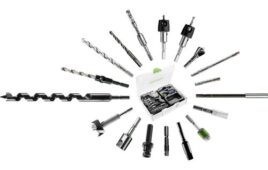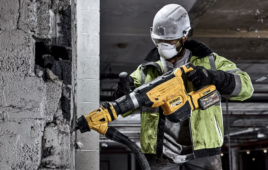The global power-tool accessories market is expected to grow at a CAGR of 6.55% during 2022-2027, according to a recent report from ResearchAndMarkets.

Rapid industrialization and increasing applications in commercial and residential construction sectors are primarily driving the power tools and accessories market. Click here to learn more or download the report.
Power tools are an efficient solution for workers across industries that also help eliminate manual labor. These tools — which include drilling and fastening tools, demolition tools, sawing and cutting tools, and material-removal tools — have gained wide use across the industrial, commercial, and residential sectors.
Industries like construction and automotive also serve as a source of innovation and product development for power tools and accessories.
Such factors are a significant contributor to the power-tool accessories market. These include:
- Drill bits
- Screwdriver bits
- Router bits
- Circular, jig saw, bandsaw saw blades, etc.
- Abrasive wheels
- Batteries
- Others
Accessory types
Based on the accessory type, the drill bits accounted for the most significant revenue, which generated U.S. $2.08 billion in 2021, and is expected to reach $2.99 billion — growing at a CAGR of 6.18% in the global power-tool accessories market. The volume of work carried out by corded and battery-operated drills have also penetrated DIY enthusiast, which can demand more replacement with the intensity of the workload.
The circular saw blades were the second-dominant segment as these tools are primarily used for wooden and metal works that need precision cutting.
The accessories used depend highly on the power tool and the work carried out. For instance, light tools like drills, drivers, and wrenches are being utilized for personal to professional purposes, demanding the need to replace bits and batteries. Similarly, the blades are the crucial components for wood and metal working where it is frequently changed in tools like a circular saw, reciprocating saw, band saw, and jig saws.
The markets
Power tools and related accessories are used for all types of construction projects, namely low rises, high rises, mass townships, etc. The rising number of residential building construction is expected to drive the demand for power tools leading to the demand for power-tool accessories.
 In India, for example, the government plans to provide housing for all by the end of 2022, which requires constructing around 30 MN low-cost houses and about 100 smart cities. This will lead to adopting modern, innovative, and green technologies and building materials for faster and quality construction of houses. It would also require necessary tools such as power tools and equipment to carry out the construction processes boosting market growth.
In India, for example, the government plans to provide housing for all by the end of 2022, which requires constructing around 30 MN low-cost houses and about 100 smart cities. This will lead to adopting modern, innovative, and green technologies and building materials for faster and quality construction of houses. It would also require necessary tools such as power tools and equipment to carry out the construction processes boosting market growth.
Technological transformation is a major factor influencing growth, and significant changes have been deployed throughout the industry, from design to installation. While the building projects are becoming more complex, stringent policies governing employee safety, using advanced precision tools, energy efficiency, and enhancing productivity are some of the major concerns.
The growing population, rising demand for public construction activities, and rising investments in renewables and telecommunications are expected to fuel the growth in the construction industry during the forecast period, stimulating the demand of the global power-tool accessories market.
Raw material costs
Raw material costs comprise about 50 to 60% of the overall cost of production in the power tools industry. The prices of primary raw materials used to manufacture power tools and their accessories — such as steel, plastic, rubber, fasteners, and batteries, have been volatile over the last few years.
The volatility of raw material prices poses a severe threat to vendor margins. Other operating expenses, such as labor wages, also sharply increase. Chinese manufacturers add more worries to the company’s top line to comply with growing demands and industry standards. These factors burden vendors that strive to produce efficient power tools and accessories at affordable prices to cope with the competition in the power-tool accessories market.
Final thoughts
The industrial end-user segment comprising major contributors such as automotive and construction industries generated the maximum revenue in the global power tool accessories market. The scenario is expected to remain consistent throughout the forecast period owing to the rising demands for sophisticated tools from the industries alongside the growth in precision manufacturing processes.
Cordless power tools are widely used in automotive, aerospace, electronics, energy, construction, shipbuilding, and other industries. However, renovation, retrofit, and DIY activities are expected to drive the market for power tool accessories in the residential and commercial segments.





Tell Us What You Think!